Windsor Tower, 5 Tudor City Place: Review and Ratings
between East 40th Street & East 41st Street View Full Building Profile
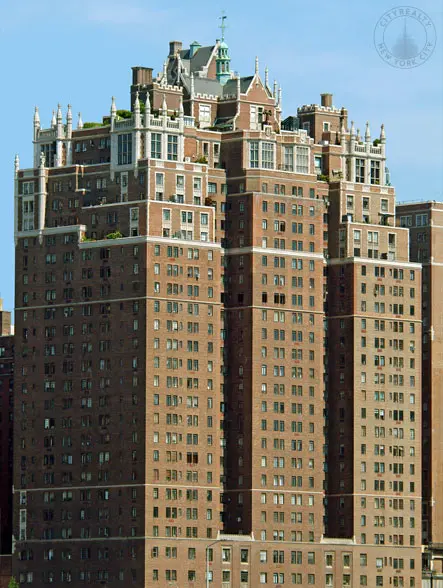

Windsor Tower at 5 Tudor City Place between 40th and 41st Streets is the grandest building in the famous Tudor City complex across from the United Nations at the far east end of 42nd Street.
The 7-story top of the brown-brick building is festooned with finials, piers and cartouches some triple-height, multi-paned windows giving the appearance of a Tudor palace on steroids, or at least stilts.
The building's addresses include 701-719 First Avenue, 1-19 Tudor City Place, 371-399 East 40th Street, and 358-368 East 41st Street.
"From the street," an August 1, 1991 article in The New York Times began, "the three-story windows that crown three of Tudor City's towers seem unimaginably luxurious. Cynics often presume that they conceal water tanks. In truth, they light the three-story living rooms of 14 apartments, some with terraces trimmed with gargoyles."
The complex, which its developer called "a city within a city," was created by Fred Fillmore French starting in 1925 when he assembled six blockfronts along Prospect Place, a small north-south street west of First Avenue that was lined most with brownstones.
According to a May 15, 1994 article by Christopher Gray in The New York Times, Mr. French had previously erected some luxury residential buildings such as 1140 Fifth Avenue "where he built a squash court into his own roof duplex and then 1010 Fifth Avenue, at 82nd Street, where he occupied the penthouse apartment with a huge roof garden."
"By 1927 he began construction on the largest single residential project New York had yet seen. By 1932 he had finished nine big apartment houses and a hotel with a total of 2,800 units that soon accommodated 4,500 residents," according to Mr. Gray.
The enclave surrounds two gardens on either side on the bluff at the end of 42nd Street.
According to Mr. Gray's article, the south garden was at first a miniaturized 18-hole golf course and "around 1950, 42nd Street was widened to produce a near-boulevard leading to the United Nations, over the protests of the French Company" and "at that time the parks were narrowed and redesigned by J. J. Levison, a landscaped designer who denatured them by removing most of their English-style accessories."
Harry B. Helmsley acquired the complex in 1970 and announced plans to build two apartment buildings on the site of the gardens, setting off a long controversy when a court ruled against the proposal.
The Landmarks Preservation Commission designated the complex and the gardens a landmark in 1988 after a coop conversion of most of the buildings by Francis Greenberger and Philip Pilevsky.
The area was once dominated by tenements near a power plant and slaughterhouses along the river and was known as "Goat Hill" and later "Prospect Hill" and then "Corcoran s Roost." Eventually it became known as a haven for waterfront thieves including the Rag Gang in the late 19th Century.
The architecture is more neo-Gothic than Tudor.
The buildings along Prospect Place have very few windows that face east because of the stench of the slaughterhouses and the lack of architectural distinction across the East River. The views that face west, however, boast spectacular vistas of midtown.
In a May 13, 1988 article in The New York Times David W. Dunlap observed that the complex consisted of "rather simple brick apartment buildings to which an exuberant profusion of limestone ornament was applied top and bottom - the Tudor rose and heraldic arms, portcullises, griffins and boar's heads" and quoted Anne Lowenstein, the co-chairman of the Historic Preservation Committee of the Tudor City Association as claiming that "the embellishments are so humanizing," adding that "they bring it down too a human scale and give it a warmth and character."
"Between the decorative elements, otherwise simple walls were animated by multiple-pane casement windows and expanses of leaded and stained glass, many contained within complex and delicate traceries," Mr. Dunlap wrote, reporting that the landmarks commission had declared the complex a landmark by a vote of 8 to 0.
Mr. Dunlap said that the complex was built under the supervision of the architect H. Douglas Ives.
Windsor tower, which has 799 apartments, is 25 stories high.
The tallest building in the complex is Woodstock Tower at 328 East 42nd Street which is 32 stories tall.
Tudor Tower at 25 Tudor City Place and Prospect Tower at 45 Tudor City Place are both 22 stories tall. Hatfield House at 304 West 41st Street is 15 stories tall. Hardwick Hall at 314 East 41st Street, Haddon Hall at 324 East 41st Street, Essex House at 325 East 41st Street, The Cloister at 321 East 43rd Street, the Manor at 333 East 43rd Street and The Hermitage at 330 East 43rd Street are 11 stories tall.
The removal of the large illuminated 30 by 50-foot "Tudor City" sign atop 45 Tudor City Place which is known as Prospect Tower was requested by the building's co-op board but the landmarks commission unanimously said it could not be removed. A November 20, 1985 article in The New York Times by Christopher Gray noted that a January 1929 photograph showed signs on top of Prospect Tower and Tudor Tower but that four years later another photographer showed that the sign atop Tudor Tower had been removed.
In the new millennium Sheldon H. Solow and other investors bought property along the East River to the south of Tudor City from Con Edison with the intention of development another major complex that would contain several thousand apartments and a major office buildings that would establish an unbroken connection with the residential projects around the Queens Midtown Tunnel approach at 35th Street. Mr. Solow eventually bought out his other investors, but by 2011 had not yet started construction.
Windsor Tower at 5 Tudor City Place between 40th and 41st Streets is the grandest building in the famous Tudor City complex across from the United Nations at the far east end of 42nd Street.
The 7-story top of the brown-brick building is festooned with finials, piers and cartouches some triple-height, multi-paned windows giving the appearance of a Tudor palace on steroids, or at least stilts.
The building's addresses include 701-719 First Avenue, 1-19 Tudor City Place, 371-399 East 40th Street, and 358-368 East 41st Street.
"From the street," an August 1, 1991 article in The New York Times began, "the three-story windows that crown three of Tudor City's towers seem unimaginably luxurious. Cynics often presume that they conceal water tanks. In truth, they light the three-story living rooms of 14 apartments, some with terraces trimmed with gargoyles."
The complex, which its developer called "a city within a city," was created by Fred Fillmore French starting in 1925 when he assembled six blockfronts along Prospect Place, a small north-south street west of First Avenue that was lined most with brownstones.
According to a May 15, 1994 article by Christopher Gray in The New York Times, Mr. French had previously erected some luxury residential buildings such as 1140 Fifth Avenue "where he built a squash court into his own roof duplex and then 1010 Fifth Avenue, at 82nd Street, where he occupied the penthouse apartment with a huge roof garden."
"By 1927 he began construction on the largest single residential project new York had yet seen. By 1932 he had finished nine big apartment houses and a hotel with a total of 2,800 units that soon accommodated 4,500 residents."
The enclave surrounds two gardens on either side on the bluff at the end of 42nd Street.
According to Mr. Gray's article, the south garden was at first a miniaturized 18-hole golf course and "around 1950, 42nd Street was widened to produce a near-boulevard leading to the United Nations, over the protests of the French Company" and "at that time the parks were narrowed and redesigned by J. J. Levison, a landscaped designer who denatured them by removing most of their English-style accessories."
Harry B. Helmsley acquired the complex in 1970 and announced plans to build two apartment buildings on the site of the gardens, setting off a long controversy when a court ruled against the proposal.
The Landmarks Preservation Commission designated the complex and the gardens a landmark in 1988 after a coop conversion by Francis Greenberger and Philip Pilevsky of most of the buildings.
The area was once dominated by tenements near a power plant and slaughterhouses along the river and was known as "Goat Hill" and later "Prospect Hill" and then "Corcoran's Roost." Eventually it because known as a haven for waterfront thieves including the Rag Gang in the late 19th Century.
The architect is more neo-Gothic than Tudor.
The buildings along Prospect Place have very few windows that face east because of the stench of the slaughterhouses and the lack of architectural distinction across the East River. The views that face west, however, boast spectacular vistas of midtown.
In a May 13, 1988 article in The New York Times David W. Dunlap observed that "rather simple brick apartment buildings to which an exuberant profusion of limestone ornament was applied top and bottom - the Tudor rose and heraldic arms, portcullises, griffins and boar's heads" and quoted Anne Lowenstein, the co-chairman of the Historic Preservation Committee of the Tudor City Association as claiming that "the embellishments are so humanizing," adding that "they bring it down too a human scale and give it a warmth and character."
"Between the decorative elements, otherwise simple walls were animated by multiple-pane casement windows and expanses of leaded and stained glass, many contained within complex and delicate traceries," Mr. Dunlap wrote, reported that the landmarks commission had declared the complex a landmark by a vote of 8 to 0.
Mr. Dunlap said that the complex was built under the supervision of the architect H. Douglas Ives.
Window tower, which has 799 apartments, is 25 stories high.
The tallest building in the complex is Woodstock Tower at 328 East 42nd Street which is 32 stories tall.
Tudor Tower at 25 Tudor City Place and Prospect Tower at 45 Tudor City Place are both 22 stories tall. Hatfield House at 304 West 41st Street is 15 stories tall. Hardwick Hall at 314 East 41st Street, Haddon Hall at 324 East 41st Street, Essex House at 325 East 41st Street, The Cloister at 321 East 43rd Street, the Manor at 333 East 43rd Street and The Hermitage at 330 East 43rd Street are 11 stories tall.
The removal of the large illuminated 30 by 50-foot "Tudor City" sign atop 45 Tudor City Place which is known as Prospect Tower was requested by the building's co-op board but the landmarks commission unanimously said it could not be removed. A November 20, 1985 article in The New York Times by Christopher Gray noted that a January 1929 photograph showed signs on top of Prospect Tower and Tudor Tower but that four year later another photographer showed that the sign atop Tudor Tower had been re moved.
In the new millennium Sheldon H. Solow and other investors bought property along the East River to the south of Tudor City from Con Edison with the intention of development another major complex that would contain several thousand apartments and a major office buildings that would establish an unbroken connection with the residential projects around the Queens Midtown Tunnel approach at 35th Street.

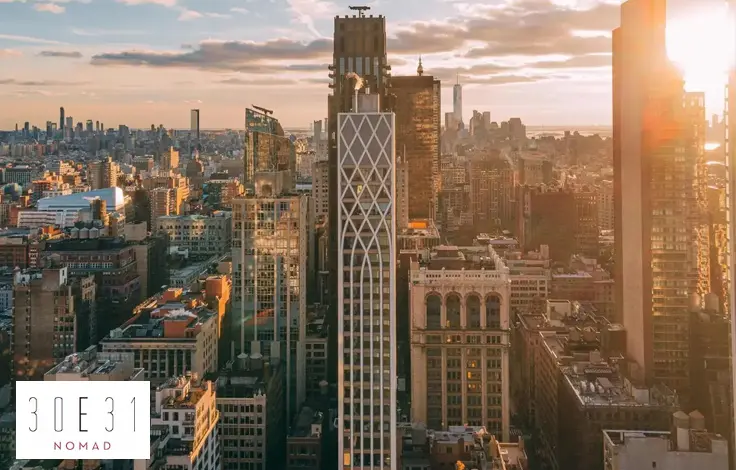
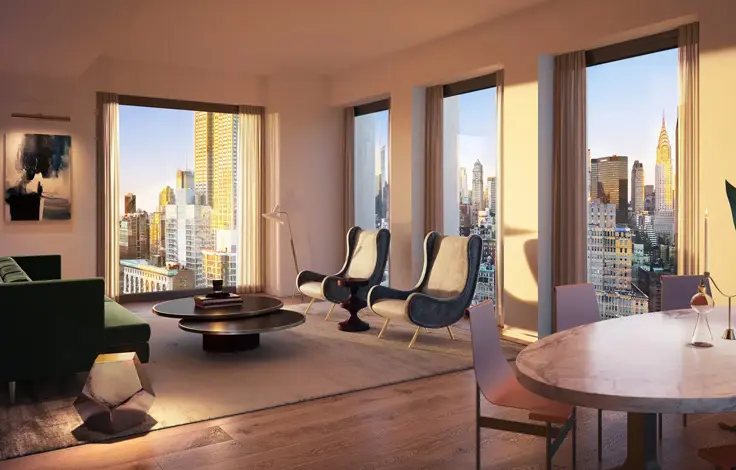

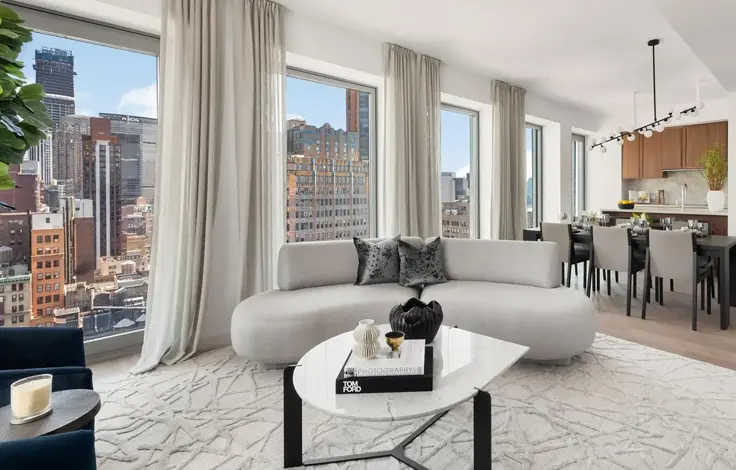
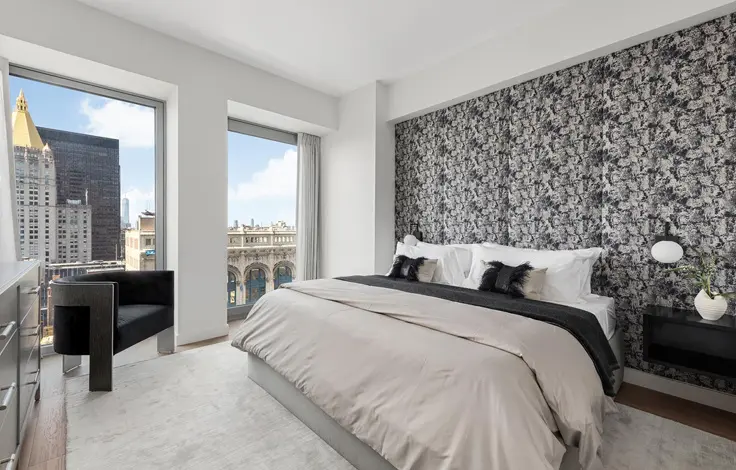
 6sqft delivers the latest on real estate, architecture, and design, straight from New York City.
6sqft delivers the latest on real estate, architecture, and design, straight from New York City.
